Examples¶
A suite of example scripts are provided in example_output to reproduce the results of this paper.
To access these examples, clone the github repository.
$ source cmf_env/bin/activate
$ git clone https://github.com/nsls-ii/constrained-matrix-factorization
$ cd constrained-matrix-factorization/example_scripts
$ python EXAMPLE_NAME
Fixing weights in a “toy” problem¶
Fixing weights has been identified as a desired use case, highlighting the challenge of retaining physically relevant components from NMF even when the weights are known a priori. This is a common situation in diffraction studies of variable composition or phase mixing, where complementary experimental information (preparation conditions or spectroscopy) may indicate the concentration of individual phases without specifying the diffraction patterns of the phases. We considered a continuous mixture of two Gaussian functions, where noise is added both to the composition and to the final function.
Run the following to produce 2 figures in example_output:
$ python fixing_weights.py
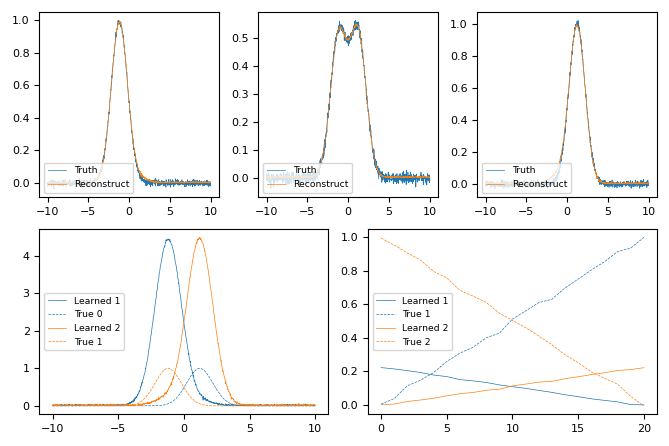
Without constraining weights, the model over-fits the data, and misses the magnitude of the components.¶
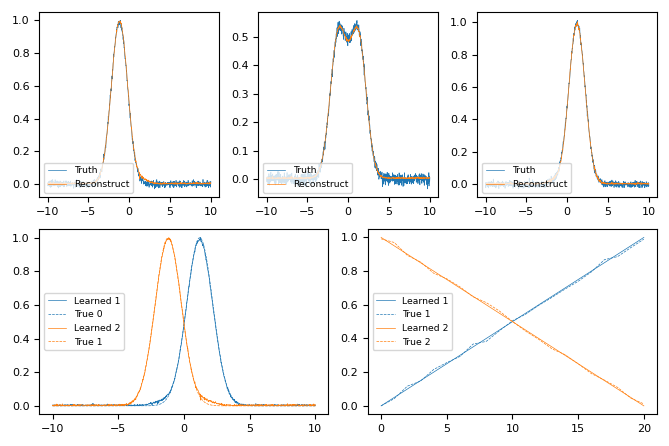
By constraining weights, the model adequately fits the data, and captures the magnitude of the components.¶
The core functionality is achieved with this code
ideal_weights = np.array(
list(zip(*[(x, 1 - x) for x in np.linspace(0, 1, X.shape[0])]))
)
input_W = [torch.tensor(w[None, :], dtype=torch.float) for w in ideal_weights.T]
nmf = NMF(
X.shape,
n_components=2,
initial_weights=input_W,
fix_weights=[True for _ in range(len(input_W))],
)
nmf.fit(torch.tensor(X), beta=2)
Fixing components in a “toy” problem¶
Prior knowledge of the components of a material is an even more common use case. We first show a purposefully complicated example combining an overlapping Lorentzian, Gaussian, and Box function linearly mixed with non-monotonically varying weights.
Run the following to produce 2 figures in example_output:
$ python fixing_components.py
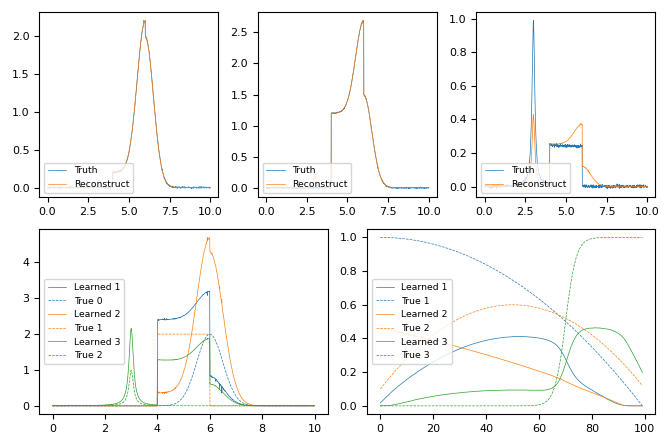
Without further constraints beyond non-negativity, the model cannot capture the complexity of the data. It fails to produce a meaningful reconstruction, useful components, nor meaningful weights.¶
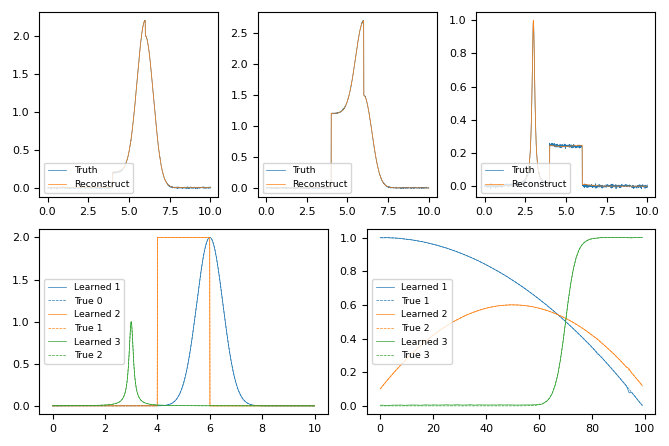
With prior knowledge of the components, the model adequately fits the data, and captures the varying magnitude of the weights.¶
The core functionality is achieved with this code
def constrained_nmf(X, components):
input_H = [
torch.tensor(component[None, :], dtype=torch.float) for component in components
]
nmf = NMF(
X.shape,
n_components=3,
initial_components=input_H,
fix_components=[True for _ in range(len(input_H))],
)
nmf.fit(torch.tensor(X), beta=2)
return nmf
Fixing components in variable temperature BaTiO3 data¶
A common challenge at the beamline is detecting phase transitions during an experiment across a state variable.
The following example will take a variable temperature dataset to produce 5 figures in example_output, with the
core result shown below.:
$ python bto.py
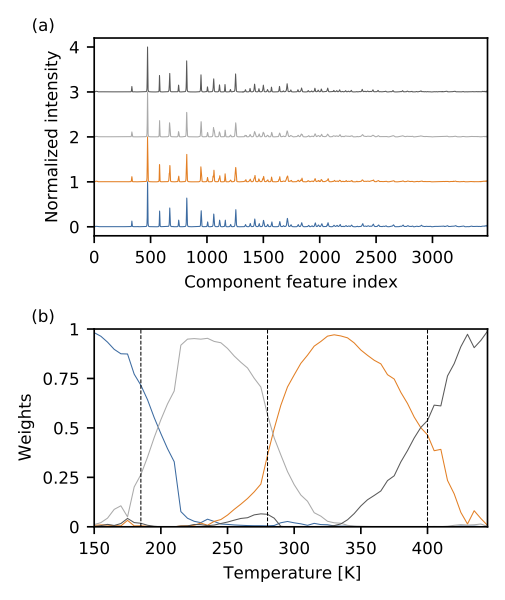
By using constraints drawn from a variable temperature dataset, we assume that the pure phases (read components) of BaTiO$_3$ will exist as prominent members of the dataset. This assumption allows for the automatic detection of phase transitions in this complicated material.¶
This example uses some helpful utilities from cmf.nmf:
- constrainedmf.nmf.utils.iterative_nmf(NMFClass, X, n_components, *, beta=2, alpha=0.0, tol=1e-08, max_iter=1000, **kwargs)[source]¶
Utility for performing NMF on a stream of data along a common state variable (Temperature or composition), that coincides with the data ordering.
- Parameters
- NMFClassclass
Child class of NMFBase
- XTensor
Data to perform NMF on
- n_componentsint
Number of components for NMF
- betaint
Beta for determining loss function
- alphafloat
Alpha for determining regularization. Default 0.0 is no regularization.
- tolfloat
Optimization tolerance
- max_iterint
Maximum optimization iterations
- kwargsdict
Passed to intialization of NMF
- Returns
- nmfslist of NMF instances
Fixing components when you’re unsure of how many components to use¶
When unsure of how many components to consider, it is customary to use the “elbow method” and consider an inflection
point in the curve comparing reconstruction loss vs the number of components. This can be extracted from the
constrainedmf.nmf.utils.sweep_components function. However, because the CMF approach is lightweight, it
can be worth while to run parallel instances and allow the expert or scientific user to interpret the results.
In the following dataset, there is a discontinuous transition, and a set of well structured components that very similar. Because NMF does not have translational invariance, a physical phenomena (thermal expansion) which causes your data to shift will be compensated by NMF casting multiple components to describe the end members of the translation. Although this is imperfect behavior, it is predictable behavior and shown in the degenerate components in the 3, 4, and 5 component analysis below.
The following example will take a molten salt dataset to produce many figures in example_output, with the
summary result shown below. The set of figures show the iterative results of increasing the number of constraints for
a given number of components (3, 4, and 5):
$ python molten_salt.py
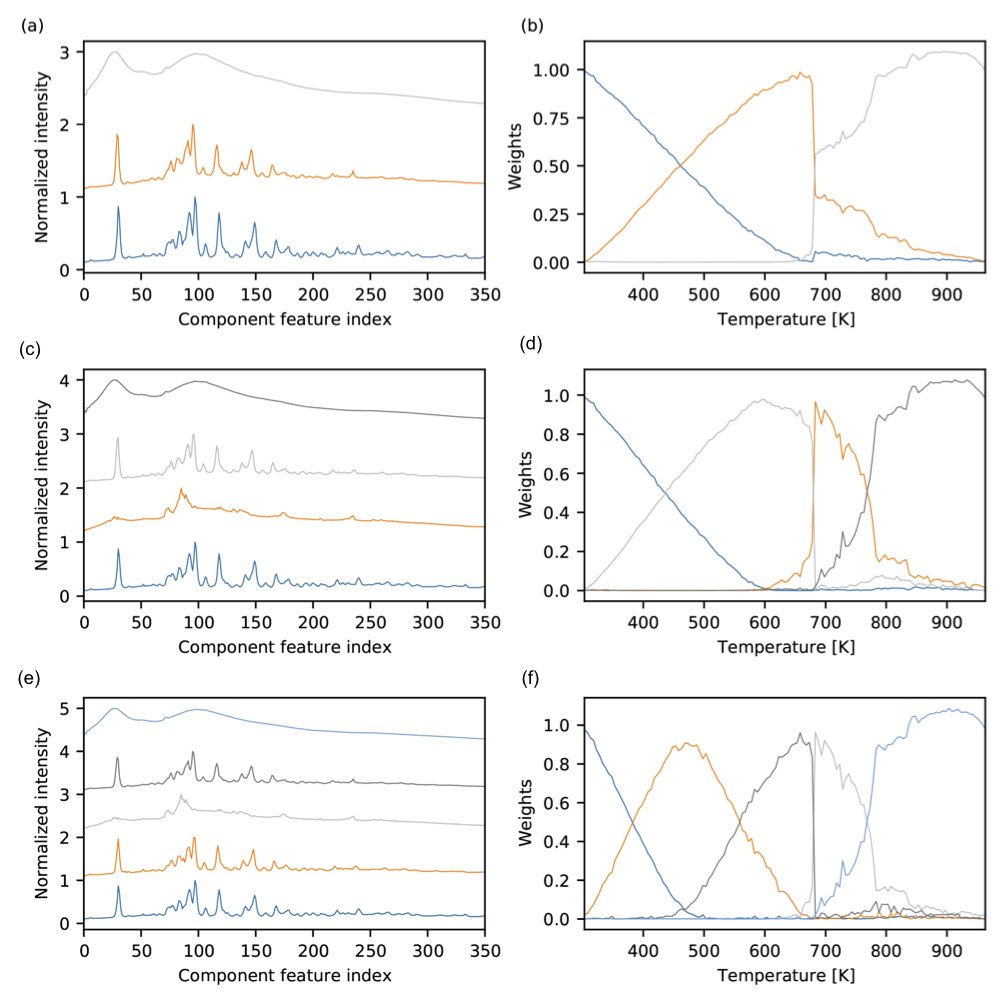
Automated constrained NMF was run using 3-5 components asynchronously on the molten salt dataset. The learned components for the (a) 3, (c) 4, and (e) 5 component decompostions provide insight into thermal expansion, and phases present during the temperature ramp. The learned weights for the (b) 3, (d) 4, and (f) 5 component decompositions demonstrate the second-order phase transition, the characteristic response to thermal expansion, and persistence of a solid phase after 400 K.¶